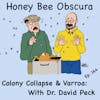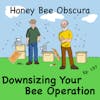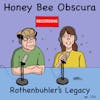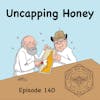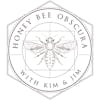What's This About Bees Eating Their Young? (120)

Jim got a call from a listener who had a question. She wrote, “I went out to my bees early this week, and in front of the hive and on the landing board I saw partially eaten larvae, larva skins and a mess, all over. What could cause that to...
 Jim got a call from a listener who had a question. She wrote, “I went out to my bees early this week, and in front of the hive and on the landing board I saw partially eaten larvae, larva skins and a mess, all over. What could cause that to happen?”
Jim got a call from a listener who had a question. She wrote, “I went out to my bees early this week, and in front of the hive and on the landing board I saw partially eaten larvae, larva skins and a mess, all over. What could cause that to happen?”
Today, Kim and Jim discuss they reason why adult bees eat the larvae. There has been some research on that subject but not much. Is it the lack of protein between pollen flows? Hygienic behavior, including the disposal of infected or varroa infested larva? Robbers eating larva as well as stealing honey?
Listen today and see if there are more reasons our Florida listener found partially eaten and completely eaten larvae in front of her hives in the first week of spring.
What do you think? Add your thoughts to the comments below!
__________________
Thanks to Betterbee for sponsoring today's episode. Betterbee’s mission is to support every beekeeper with excellent customer  service, continued education and quality equipment. From their colorful and informative catalog to their support of beekeeper educational activities, including this podcast series, Betterbee truly is Beekeepers Serving Beekeepers. See for yourself at www.betterbee.com
service, continued education and quality equipment. From their colorful and informative catalog to their support of beekeeper educational activities, including this podcast series, Betterbee truly is Beekeepers Serving Beekeepers. See for yourself at www.betterbee.com
______________________
Honey Bee Obscura is brought to you by Growing Planet Media, LLC, the home of Beekeeping Today Podcast.
Music: Heart & Soul by Gyom, All We Know by Midway Music, original guitar music by Jeffrey Ott
Copyright © 2023 by Growing Planet Media, LLC

Episode 120 – What's This About Bees Eating Their Young?
Jim Tew: Good morning, Kim. You're in good spirits?
Kim Flottum: I am. It's the second day of spring. It's only 34 degrees and they're talking about cold rain this afternoon. I'm getting tired of the weather, but other than that, things are going okay.
Jim: That sounds like a beautiful day to me compared to what it could be. I want to tell you what happened. This is really just a conversation, Kim, but I got a call from Becca. Becca, you know who you are there in North Florida. She asked me why bees inside the hive were eating some of her bees and tossing out the partially eaten remains. What was going on? I was caught off guard. I wasn't prepared for the question. I did the best I could, and believe it or not, that question has had me thinking ever since then. I've done some reading. What do you know about this so far?
Kim: I've seen it here in my yard once and in somebody else's yard because they called me over to ask me what was going on. I've seen it a couple of times over the years, and both times that I saw it, what was going on outside the hive was driving what was going on inside the hive, and what was going on outside the hive had been a tremendous spring flow, just wonderful. A storm moved in and it snowed for three days and it stayed below 30 for three more.
Jim: Now, that's a lot of information. You clearly don't mind talking about this, so let's go with that. Hi, I'm Jim Tew.
Kim: I'm Kim Flottum.
Jim: Today we want to talk about cannibalistic bees. It's really a bright, upbeat subject for the second day of spring on a cold day.
Introduction: You are listening to Honey Bee Obscura, brought to you by Growing Planet Media, the folks behind Beekeeping Today podcast. Each week on Honey Bee Obscura, hosts, Kim Flottum and Jim Tew, explore the complexities, the beauty, the fun, and the challenges of managing honey bees in today's world. Get ready for an engaging discussion to delight and inform all beekeepers. If you're a long-timer or just starting out, sit back and enjoy the next several minutes as Kim and Jim explore all things honey bees.
Jim: I don't know what to say, Kim. I thought about this subject ever since she brought it up. These bees eating bees is always just casually mentioned and then glossed over, but there's no other word for it other than cannibalism. All the book chapters when you're getting down in the dirty end parts of the depth of the information, it'll say, "Yes, under the right conditions, bees will eat the young larvae because it's just a food source to them."
We agree with that and we move on, but I want to ask you, Kim, if this were any animal other than bees, would we be as placid about it? If I had a dog and she was eating her puppies, I'd take a dim view of that. Help me out here because this is not a bright cheerful subject, is it? It's pretty unseemly it seems like.
Kim: There are some people who take that to the extreme, I guess, and they say that small children are meant to be eaten.
Jim: That's not what people say, Kim.
Kim: The only reference I've ever had to it, I've never looked it up, so I'm going on hearsay, and the hearsay came from Dr. Roger Morse at Cornell early back when I was running the Bee Culture magazine. He told me in two short sentences, "There's not enough food. They're getting rid of the young so they don't have to feed them. Next question." That was like what you said.
Jim: Yes. That's it. That's exactly the point I'm trying to make. Is that information scant because it's despicable, or is that information scant because we don't know a lot?
Kim: I'm thinking it's the latter rather than the former. I can't imagine getting a PhD in entomology on why bees eat their young siblings in a beehive. I don't know. What Roger said to me made sense. You have to make a choice. You can feed the kids, but if this food shortage continues, you're going to run out of food and they're going to die anyway. Do you get rid of them because then you've still got a queen and you've still got nurse bees that can take care of the next flush of brood whenever?
Jim: It just gets worse, Kim, because the bees select the brood that they're going to repurpose as food and they keep the other older brood. It's like some bad movie where some offspring are kept and other offspring are used as a food source to repower the brood food glands to then go feed the siblings with what had heretofore been their offspring. This just gets uglier and uglier.
Yes, I agree. There's a lot of work done. If you look up cannibalistic honey bees, there's work that's going on right now, has gone on, and yes, it seems to be related in many cases to a pollen flow or lack of a pollen flow. I don't know what happened in Becca's bees, but since she was already well into spring, I suspect something disrupted the protein supply and the bees outran what they had available to them.
They turned to eating the young larvae, and in some cases, the older larvae, because the investment has already been made in the pupae. There's nothing to be gained by killing them. They're close enough to being mature adults as to be useful, and they leave the eggs because there's been no investment made in that.
We call it a bad decision on the weather and we don't have enough pollen, so here's our food reserve. It's all we got in the cupboard are these young bees, so we will repurpose them and start over again as soon as the weather changes. Shoot a hole in any of that because this is conversation, this is not lecture.
Kim: What you brought up on eggs piques my interest. It would be interesting to know, had she looked in a hive, were there eggs there? Now, you just mentioned eggs with no investment and I hadn't thought of it that way, but in three days they're going to be an investment. Are there eggs in hive when that starts or do eggs go way before that or at the same time? I don't know that, but that would be a good thing to know.
Jim: I think, in general, eggs are spared. It is three days, but three days in the spring can be a radical difference. The rain stops, the plants retool. Now, I've said several times, and I'll say it again, I'm making this up as I go along. This is conversation hypothesis and not factual information. There's that. The other thing that has to be noted is when I did this quick read just to see if any work was done on cannibalistic bees, it is a unique way for virus invaders to spread inside the colony.
This is a totally separate subject. Maybe the bees in Florida were not protein starved. Maybe they were in some case virally infected and the bees were throwing them out. Normally, hygienic behavior is a good thing, but in this case, it bites the bees on their bee butts because by eating virally infected larvae, then they infect, apparently, their brood food glands and then they become spreaders of the virus throughout the colony. Kim, this is just from a quick read. This is not a complete literature review. This is just a quick read.
Kim: Boy, I hadn't thought of that either. Let me bring up another question.
Jim: Before you do that, Kim, let's take a break. We're just tumbling all over ourselves here telling things we don't know for sure. Let's take a break, catch our breath, organize our thoughts.
Betterbee: We know you have options when it comes to shopping for beekeeping supplies. What we believe sets better bee apart are three things. First, our commitment to innovating, trying out new products in our own apiaries, and then sharing them with you. Second, our focus on education and helpful customer service. Third but not last, our fundamental company goal, to help you be a successful beekeeper. Give us a call to learn more about any of our products or to ask a beekeeping question. We've got you covered. Visit betterbee.com to shop online today.
Jim: Kim, I feel better. Go ahead and finish your comment now.
Kim: She said they were partially eaten, and I wonder, because when I talked to Roger, he didn't mention eating. He just mentioned discarding them. You pull a larva out of a cell and stick it outside, it's pretty much dead. You don't have to kill it. I wonder if her larva were being eaten by the bees inside, and I'm guessing here, I just don't know. If they were eaten, why didn't they eat all of the larva?
Jim: I don't know. Are you talking hypothetically? Maybe they did eat all of the larvae. Maybe they just ate selected larvae. I guess I would weasel word that sometimes, depending on the direness of the situation, they eat everything if they're really starving. Other times, it may be a worker here and a worker there who makes the decision.
Kim, there's also, some of the quick papers I read was that workers may decide that this particular developing larva is undernourished, not performing, not developing for whatever the reason and take it out. Kim, I want to stop right here and say you've referred to eating, I've referred to eating, the literature refers to eating.
I don't fully understand the mechanical procedure that a worker bee does to actually eat a larva since they have to almost imbibe their food, drink their food. How are they actually eating anything? They don't have little bee teeth. Are they just taking out body juices or are they, in some way, liquefying the body tissues that they can so that it's drinkable? We always make a reference to bees eating bees, but I don't see the mechanical process. I don't understand the mechanical process for doing that. Is that why the larval skins are thrown out?
Kim: You just brought an image to mind here for a moment. I can just imagine a nurse bee sticking her head into a cell with a small larva in it, regurgitating a big load of honey, biting off the larva's head, stirring it around with her antenna, and drinking it up, a honey cocktail. [laughter]
Jim: I'm thinking, I would go a different way. I wonder if she's regurgitating saliva. Is she using enzymes? Listeners, we're making this up. I want to be crystal clear that this is just Kim and me talking with ourselves and you. I suppose in light of not having studied the literature, that this is a short, quick digestive process and it's the reason they're not always thorough.
In this discussion, questions beget questions. If this is a food source, why don't robber bees invest more time in actually destroying the brood also or do they? I just hadn't been looking for it. I've been watching for robbers taking the honey, and I didn't notice the fact that some of the robbers also kill some of the edible food grade larvae. How did this eating thing, if robbing is an issue and everybody's out there ping and stealing, why don't they take all the food inside the colony instead of just the carbohydrate sources? Unless they did take some of the brew, but compared to the honey sources, the quantity was inconsequential.
Kim: I'll go back to the thing Roger told me about. There was a lot of honey stored in those colonies and then suddenly, like you said, honey and pollen quit coming in, and they had a bunch of hungry mouths to feed and they had no way to feed them. They could feed them honey, but you need more than that. You need a protein source. What you said makes sense in a way, and I'm certainly going to watch for it. I'm thinking anybody listening here might want to watch for it too and see, not only take a look at what's outside the hive but take a look at what's going on in the brood nest.
Jim: Yes, I agree. I've seen this all through the years, there's a pupa on the landing board. How many pupae? I don't know. Three. Not a problem. Don't worry about it. There's actually a good reason why that pupa was out there. In many cases, partially eaten. They broke it up, pulling it out of the cell, I don't know, or was it partially eaten? The whole point is, Kim, I've never really looked at this until the question came up and it made me sit around thinking for a few days trying to come up.
The thing that I do know for sure is that cannibalism inside the hive is fairly routine. If something isn't right, they get eaten, they get tossed, they get pulled out of the system. They're not going to invest the energy in them. It happens to drones, it happens to developing queens that aren't necessary because other queens emerged first and the other queens were torn down, thrown out. I don't think that they're snacked on, but bees killing bees, bees eating bees, kind of a dirty world in there, isn't it, Kim?
Kim: It takes, let's say, air out of the balloon of gentle bees.
Jim: Yes, it really does. When you see a bee on a blossom, she's got a real sortid history, boy. [laughter]
Kim: Maybe she's bad lucky she's there.
Jim: Right. She was lucky she wasn't eaten as they're developing like her siblings were and used to feed her. It's crystal clear, Kim. It was an interesting thought that I had on how this cannibalistic procedure lets the bees adjust to the vagaries of the season. All of a sudden, it turns cold just like it did here recently. I know my bees have brooded up. Maple was in full bloom and then, kaboom, back to 16 degrees.
I made the thought, "Well, I sure hope my bees have some reserves left out there. If I go open them, it's going to cause all kinds of grief, so just lead them alone and hope for the best." What if they're dealing with that inside that dark cold hive? They're making some life and death decisions for the colony that result in the death of some of the developing larvae there.
Kim: The thing is you probably could stop it before it starts or slow it down once it does start by putting on a couple of protein patties.
Jim: That was the last thing on my list. [laughter] That was the last thing on my discussion list here today. Should we really take these protein patties seriously? Will protein patties help bees during a pollen dearth? Now, I don't think they will help during a disease situation, but during a pollen dearth, I put them on anyway. Have I've been doing the right thing or is that-- How helpful is that? Can't go wrong. I guess that could be a dangerous recommendation that you and I are considering, not making, but considering, put on a pollen patty.
Kim: It's a guess. 60 feet away, it makes perfect sense. Getting closer to it, I'm not so sure, but 60 feet away, it makes perfect sense. Have it and don't need it rather than don't have it and have a bunch of dead bees out in front of your colony.
Jim: I think I've punched this out. I may come back to this later on as I-- It depends on how long my curiosity holds up, but this much I'm sure of, bees will eat their siblings in times of extreme need. The questions flow like water, which larvae are eaten, how long, how extreme was the need? Which nurse bee made the decision? Was it a pollen protein shortage or was it a disease issue? How do the bees actually eat that larvae? It's interesting, to me, an interesting discussion that I don't have a lot of answers to, except this is common. We allude to it and we all move right on.
Kim: Listening to you here, one more thought came to my mind and that was extreme-- What's the word I want? Extreme cleaning behavior. A house bee stuck her head in that cell and said, "There's varroa mite larvae in here along with this bee larva. If I pull the bee larva out, I already can get rid of two or three varroa at the same time."
Jim: I think you're onto something because one of the quick papers I read was that this whole process of eating is a house-cleaning process. If the larvae are dead or dying and the nurse bees perceives that, better to eat it now before it dies and has something sporulate or mold growth occur. For hive hygiene, colony hygienity, get that thing out of here right away.
Kim: We've got four good answers on the table. Which one do you want?
Jim: We have four good ones on the table? I thought we had four poorly thought ideas on the table. I'm going to go with the bees are eating selected young that they have not yet made a great investment in in times of extreme dearth, number one. Number two, it looks like bees that can perceive a pathogenic situation are either eating or destroying various stages, probably larvae, that are danger to the health of the colony. Then lastly, it could be nothing more than what Kim Flottum said, extreme hive hygienic behavior, but bees will kill each other.
I don't ever want to be a drone on a beehive. Everything you do results in your death. If you're successful in mating, you die. If you're not successful in mating, you're kicked out of the colony and you die. If you're not needed and there's plenty of drones and there's a dearth, you die. Do you see a basic trend for a drone? I don't want to be a drone in a beehive.
Kim: I think I got you there. I don't know if we got this answered or not, but it'll get me to look for some things later this season and maybe see if I can talk to somebody that knows more about it than I do.
Jim: I enjoyed the conversation. I wish I knew more for the listeners. Think about it and see what we can come up with here.
Kim: Before we go, can I remind you of something? There's a new blog on growingplanetmedia.com. It's our mother company's webpage. Basically, what it's on is climate change and what it's going to do to bees, beekeeping, and beekeepers. I'm looking at a specialized part of this but take a look. Let us know what you think.
Jim: I enjoy talking to you, buddy.
Kim: Till next time.
Jim: Till next time. Bye-Bye.
[00:21:37] [END OF AUDIO]
New to Honey Bee Obscura Podcast?
Here are some great episodes to start with. Or, check out episodes by topic.









